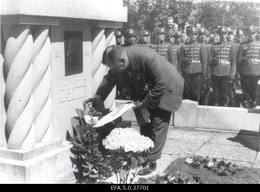Julius Kuperjanovas ir jo kapas
Estijos nepriklausomybės kovų didvyrio Juliaus Kuperjanovo kapas sovietmečiu tapo pasipriešinimo simboliu.
Nepriklausomybės kovų didvyrio Juliaus Kuperjanovo kapas sovietmečiu tapo pasipriešinimo simboliu.
Kuperjanovas ir jo kapas okupacijos metais tapo laisvės kovų simboliais. Prieštaravimą žmonės išreiškė Kūčių vakarą prie kapo nešdami gėles ir žvakutes, pažymėdami kitas progas. Dėl valstybės saugumo daug studentų buvo pašalinta iš Tartu universiteto ir atleisti žmonės iš Tartu universiteto, reaguodami į protestą.
Kuperjanovo žmona Alisa taip pat aktyviai dalyvavo kare, 1918 ir 1919 m. padėjo organizuoti ir steigti partizanų būrius bei Gynybos lygą. Tapusi našle, ji pradėjo vadovauti Moterų savanoriškai gynybos organizacijai, aktyviai dalyvavo vaikų apsaugos organizacijose. Sovietų režimas ją nuteisė mirties bausme. Jai buvo įvykdyta mirties bausmė Sverdlovsko srityje 1942 m.
Vootele Hansen 2021.01.31
Susijusios vietos
Tomb of Lieutenant Julius Kuperjanov
This monument is situated in Raadi Cemetery in Tartu, to the left of the main pathway in the section near Kruusamäe Street.
The tombstone of War of Independence hero Lieutenant Julius Kuperjanov was designed by renowned Estonian sculptor Jaan Koort and unveiled on 11 October 1925. During the Soviet era, the bronze low-relief and the texts on the monument were removed. The tombstone itself was not demolished, however, and it became a symbol of resistance against the foreign regime, with flowers and candles secretly being placed there. The monument has been restored to its original state.






